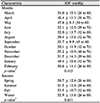Abstract
Purpose
To investigate seasonal variations in the incidence of acute primary angle closure (PAC) attack and to identify climatic factors associated with the frequency of angle closure attack.
Methods
A retrospective analysis of proven cases of acute PAC attack from hospital records over a 10-year period from January 2009 to December 2018 at a tertiary hospital. The study was performed to identify and analyze sex, age on diagnosis, onset timing of symptoms. And then, compared the seasonal occurrence rates and analyzed the correlation between climatic factors and occurrence frequency.
Results
A total of 227 patients of 227 eyes were diagnosed as acute PAC attack. There were 57 men and 170 women, mean age was 67.0 ± 9.1 years and the highest rate was in the 60s (38.3%). There was a statistically significant increase of acute angle closure attack incidence in women in winter (p = 0.002). In the case of climate factors, there was a negative correlation with the average temperature and the sunshine time (r = −0.657, p = 0.030; r = −0.583, p = 0.046, respectively). There was no significant correlation with the average humidity and the rate of sunshine (r = −0.288, p = 0.364; r = 0.021, p = 0.948, respectively).
Figures and Tables
 | Figure 1Cumulative monthly incidence of acute angle closure attack over the 10 years. The highest angle closure attack incidence was in December (n = 25, 11%), followed by February and March (n = 24, 10.6%, respectively). According to sex, male (light gray bar) showed highest incidence in March (n = 11, 19.3%), female (dark gray bar) in February (n = 22, 12.9%). |
 | Figure 2Seasonal cumulative incidence of acute angle closure attack over the 10 years. There was a statistically significant increase of acute angle closure attack incidence in winter (top graph, n = 71, 31.2%, p = 0.019). Other seasons not showed statistically significant difference of incidence. There was no difference in the incidence according to season in males (center graph). In female, there was significant higher acute angle closure attack incidence in winter (bottom graph, p = 0.002). |
 | Figure 3Correlation of acute angle closure attack incidence with each monthly climatic factor. Mean temperature and sunshine hours were significantly correlated with acute angle closure attack incidence (left upper and lower). Humidity and sunshine rate were not significantly correlated with acute angle closure attack incidence (right upper and lower). |
References
1. Choong YF, Irfan S, Menage MJ. Acute angle closure glaucoma: an evaluation of a protocol for acute treatment. Eye (Lond). 1999; 13(Pt 5):613–616.
2. An JW, On KK, Kim JD. Biometric measurements in acute angle closure glaucoma. J Korean Ophthalmol Soc. 1993; 34:648–653.
3. Wright C, Tawfik MA, Waisbourd M, Katz LJ. Primary angle-closure glaucoma: an update. Acta Ophthalmol. 2016; 94:217–225.
4. Friedman DS, Gazzard G, Foster P, et al. Ultrasonographic biomicroscopy, Scheimpflug photography, and novel provocative tests in contralateral eyes of Chinese patients initially seen with acute angle closure. Arch Ophthalmol. 2003; 121:633–642.
5. Shily BG. Psychophysiological stress, elevated intraocular pressure, and acute closed-angle glaucoma. Am J Optom Physiol Opt. 1987; 64:866–870.
6. Hong C, Yamamoto T. Angle closure glaucoma. In : Park KH, Kim DM, Hong C, editors. Acute angle closure. Amsterdam: Kugler Publications;2007. p. 125.
7. Hyams SW, Friedman Z, Neumann E. Elevated intraocular pressure in the prone position. A new provocative test for angle-closure glaucoma. Am J Ophthalmol. 1968; 66:661–672.
8. Sihota R, Mohan S, Dada T, et al. An evaluation of the darkroom prone provocative test in family members of primary angle closure glaucoma patients. Eye (Lond). 2007; 21:984–989.
9. Tupling MR, Junet EJ. Meteorological triggering of acute glaucoma attacks. Trans Ophthalmol Soc U K. 1977; 97:185–188.
10. Ivanisević M, Erceg M, Smoljanović A, Trosić Z. The incidence and seasonal variations of acute primary angle-closure glaucoma. Coll Antropol. 2002; 26:41–45.
11. Hillman JS, Turner JD. Association between acute glaucoma and the weather and sunspot activity. Br J Ophthalmol. 1977; 61:512–516.
12. Lee TY, Yu S, Kim JH, et al. Seasonal variations of acute angle-closure glaucoma in patients visiting the hospital. J Korean Ophthalmol Soc. 2012; 53:1637–1641.
13. Zhu J, Xu Y, Wang H, et al. The seasonality of acute attack of primary angle-closure glaucoma in Beijing, China. Sci Rep. 2018; 8:4036.
14. Hu CC, Lin HC, Chen CS. A 7-year population study of primary angle closure glaucoma admissions and climate in Taiwan. Ophthalmic Epidemiol. 2008; 15:66–72.
15. Bojić L, Vojniković B, Karelović D, Jukić-Lesina T. Acute angle-closed glaucoma and meteorological factors in Split, Croatia. Coll Antropol. 2001; 25 Suppl:105–109.
16. Seah SK, Foster PJ, Chew PT, et al. Incidence of acute primary angleclosure glaucoma in Singapore. An island-wide survey. Arch Ophthalmol. 1997; 115:1436–1440.
17. Ch'ng TW, Mosavi SA, Noor Azimah AA, et al. Monsoon and primary acute angle closure in Malaysia. Med J Malaysia. 2013; 68:410–414.
18. David R, Tessler Z, Yassur Y. Epidemiology of acute angle-closure glaucoma: incidence and seasonal variations. Ophthalmologica. 1985; 191:4–7.
19. Teikari JM, O'Donnell J, Nurminen M, Raivio I. Acute closed angle glaucoma and sunshine. J Epidemiol Community Health. 1991; 45:291–293.
20. Teikari JM, Raivio I, Nurminen M. Incidence of acute glaucoma in Finland 1973 to 1982. Graefes Arch Clin Exp Ophthalmol. 1987; 225:357–360.
21. Lai JS, Lin DT, Tham CC, et al. Epidemiology of acute primary angle-closure glaucoma in the Hong Kong Chinese population: prospective study. Hong Kong Med J. 2001; 7:118–123.




 PDF
PDF ePub
ePub Citation
Citation Print
Print





 XML Download
XML Download